#anjous daughter
Explore tagged Tumblr posts
Text
TWQ 10th Anniversary
THE WHITE QUEEN 10-Year Anniversary Week
->Favorite Villain




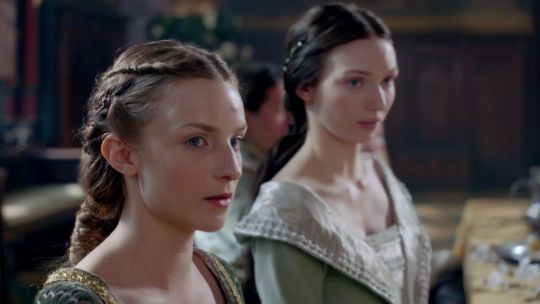
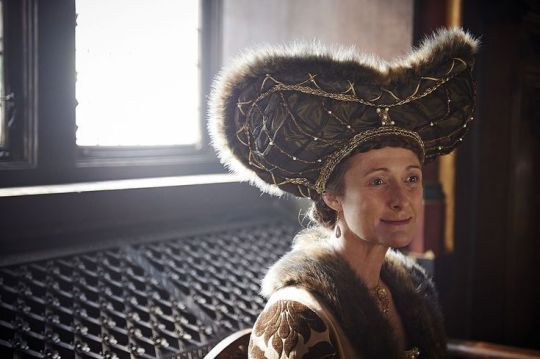
In the midst of playing fast and loose with known historical facts, its wild costuming decisions, and some deeply questionable narrative choices, the one thing that stood out in The White Queen was the portrayal of its central cast of characters, all women, cast in various shades of grey, caught somewhere between damsel in distress and femme fatale. Not especially heroic, they were nevertheless complex and layered. In protecting what was important to them (their children), they strayed far from what tradition requires of heroines: to be pure, good-natured, ethical. Indeed, their behavior often called into question what it means to be a heroine. They were all villains!
Or were they? What if they were just victims of this story's ultimate and invincible villain, Fortune's Wheel?
“Fortune's wheel takes you very high and then throws you very low, and there is nothing you can do but face the turn of it with courage.”
#twq10#the white queen#of mothers and daughters#historical shenanigans#jacquetta of luxembourg#elizabeth woodville#nan beauchamp#margaret beaufort#margaret of anjou#cecily neville#isabel neville#anne neville
14 notes
·
View notes
Note
I got the same ask, so I just want to add what Kristen L. Geaman wrote, which sums it up:
"It is time to stop seeing queens as apolitical or politically active queens as exceptional: "The question is not whether women exercised power; it is how and why."
All three WotR queens were in such wildly different situations, it's frankly impossible to conduct a side-by-side examination to decide which one of them had "the most" power/influence/authority. Theoretically, however, they all had the same social & institutional power and scope of action and used it accordingly.
(To be clear, this includes Margaret of Anjou. We really cannot claim that she had "the greatest power and influence" by any reasonable parameter because her power and influence in itself was really no different from any other 15th or 14th century queen: what was different - or more importantly, was perceived as different - was the situation around her and the manner in which it forced her to use that power and influence (ie: "how" and "why"). This was in the later half of her queenship, not from the beginning. And even then, it's possible that the perception of her activities say more about her husband's position/authority than her own, or may say more about how her enemies wanted her to be perceived rather than an accurate reflection of her actual actions. We just don't know).
This logic applies to a very similar ask I received on the same topic: whether the perception of gender changed across the WotR and late 15th century. "Gender" by itself is too broad a concept (and for who? For women in general? For noblewomen? For queens?), but even if we narrow it down to the four queens in question, it's impossible to form a conclusion and unwise to even try. There are so many wildly different factors that influenced the four queens' activities and perception beyond their gender - their social status, nationality, length of queenship, political opposition and the propaganda it generated (etc) - that to compare them through a solely gendered wavelength feels very limited and rather dishonest. We can perhaps compare some aspects of their queenship (eg: Margaret and EW's roles in their sons' councils - see below) but those are individual elements and should be analyzed across a broader spectrum of late medieval English queens - it shouldn't just be merely limited to the WotR ones.
An example that comes to mind about the circumstantial differences of the three queens is their role in their children's marriages. Margaret was in a rare and unique position to negotiate her son’s dynastic marriage on her own due to the absence of the king, and did a great job; but this cannot by any means be used to judge how she would act in more “regular” circumstances. None of Elizabeth Woodville’s royal children married during her queenship except for her youngest son Richard, who didn't marry a foreign bride but an English heiress for monetary rather than dynastic purposes; she nonetheless played a significant role in his wedding, and her husband’s will specified that she was to "rule and govern" her daughters' marriages. Elizabeth of York’s eldest son and her eldest daughter made grand foreign marriages during her queenship under the most "regular" circumstances; she played an especially vital role in the latter, something that is regularly overlooked by historians. In any case, the situations of all three queens were wildly different: we can't use them to compare who did "the most" or how a WotR English queen's role "evolved". It wouldn't be a fair line of analysis.
For another example, take queenly dowers. We can't compare what Margaret of Anjou got with what Elizabeth Woodville & Elizabeth of York got on a "gendered" or even "queenly" lens (as historians tend to do, often for EoY and occasionally for EW) because Henry VII and Edward IV simply could not logistically endow their queens on the same capacity as Margaret was endowed. It was objectively a practical problem, not an ideological one. Even if they had been kings in regular circumstances, such a dower was financially unwise; as usurpers with a very limited supply of lands, it was completely unfeasible. This unfeasibility is especially true in EW's case because as an English gentlewoman with no dowry/political alliance/prestige of her own, she brought no advantage whatsoever to the king or to England, and marriage to her in fact made them lose an invaluable diplomatic card that could have potentially spelt disaster for their dynasty. It would have therefore been somewhat expected for her to receive a lesser dower in that circumstance - though of course, ultimately speaking, royal supply was limited and she might've probably been given the same high amount if more was available. That's not even getting into how Edward IV himself was running his own household on a significantly lesser budget than both Henry VI and Henry VII did, meaning that EW's dower had nothing to do with queenship and everything to do with royal policy as a whole. (I'm not getting into Henry VII and Elizabeth of York's situation because ik you've already talked about it a lot, but suffice to say, the idea that he was using her dower to somehow "control" her is nonsense. If anyone wants an example of a king of England who actually seized his wife's dower lands, look up Edward II and Isabella of France; if anyone wants an example of a queen consort whose ability to administrate and collect income from her dower lands was neglected and overlooked by her husband, look up Berengaria of Navarre. There are queens who this accusation actually applies to; Elizabeth of York isn't one of them.)
There's also the major problem of historical evidence. To claim that we can "compare" the influence and activities of the three queens is 1) to imply that we have surviving evidence for all their activities as queen, and 2) more importantly, to imply that we have equal surviving evidence for all their activities as queen. We really, really don't. More than *120 letters* have survived for Margaret of Anjou, meaning that we know infinitely more about her "daily" queenship than any other 15th century queen. It doesn't mean that she did more; it merely means that, because evidence has been lucky enough to survive for her, we know more about her activities as queen (patronage, intercession, diplomacy). I would kill to have the same amount of information for Elizabeth Woodville and Elizabeth of York: it would help flesh out their queenships so much. It would also go a long way in further establishing their personalities, their relationships with other nobles, their approaches to lordship, etc. But for now, information is very limited, and that needs to be kept in mind & specified when discussing both the Elizabeths, just like it needs to be kept in mind & specified when discussing Margaret (ie: she shouldn't be singularized). Similarly, there's also a very uneven level of contemporary evidence for late medieval English kings' reigns in general: for example, as Charles Ross has said, "The reign of Edward IV was singularly ill-served by contemporary writers of history". We possess very less strictly contemporary information about his reign, and this massive gap is "only very partially filled by the vernacular city chronicles". His entire chamber records don't survive: imagine how much royal activity has consequently been lost, and how little we know about him & EW compared to Henry VII & EoY as a result. Henry VI's reign also has this major problem when it comes to lack of surviving contemporary information, though like I mentioned, the survival of letters for Margaret of Anjou mean that the lack of information is relatively alleviated when it comes to her queenship and actions specifically. We also have more detailed extant information for Elizabeth of York's diplomatic role & activities compared to her predecessors, from what I understand, thanks to ambaassadorial letters. The point is simply that with such uneven evidence which directly affects the way we perceive their queenly activities, it doesn't really make sense to "compare" them. Rather, I think it would make more sense to analyze them individually and acknowledge their vastly different circumstances when doing so. On a broader theoretical level, like I mentioned, we know for a fact that they all had the same social & institutional power and scope of action. What was different was their circumstances (ie: "how" and "why").
One thing I do want to point out, though, is that Elizabeth Woodville did have unique political authority during her tenure as queen. Her official appointment in royal councils in her own right - for both the crown prince and Richard of Shrewsbury - was unusual & exceptional for late medieval queens, even though historians rarely emphasize it to the extent that they should. Margaret, whose activities with her son's council are often hailed as "extraordinary" and proof of her "superior" political power (I'm putting them in quotes because they're the words I come across), was in fact never actually a part of the council in her own right and never came close to possessing the position, authority or formally acknowledged importance that Elizabeth had. So, I would say that yes, Elizabeth Woodville was undoubtedly given unconventional political authority & formal appointments during her queenship, made even more surprising by the fact that these were not during the King's absence or incapacity but during his presence and the peak of his own power. Historians need to acknowledge and highlight this more than they do. However, any "comparison" (if it can be called that) of this unique and official position of Elizabeth's can't just be limited to her daughter or other WotR queens, and therefore can't be used to judge Elizabeth of York: it was unusual and unprecedented for all 15th century (from what I understand, also 14th century) queens in general and should be discussed accordingly.
What are the differences in the powers of the three queens in wars of the roses? Margaret of Anjou should be the greatest power and influence? Elizabeth Woodville has many formal authorities, and Elizabeth of York is very symbolic?
No because all medieval queens consort had both formal and symbolic authority. Please check my queenship tag to find out more.
#I hope it's okay if I added this!#It was kinda scary lol - I was just starting to answer this same ask and then saw your post 😅#queenship tag#I don't think I explained the last point well but what I mean is that it's not fair to solely compare Elizabeth of York to Elizabeth#Woodville and claim that EoY lacked the formal position & authority her mother was given when it came to their sons' councils -#because no other 14th or 15th century queen had that position or authority either (including Isabella of France and Margaret of Anjou)#The position given to EW was the unusual exception not the rule -#so how can we solely judge Elizabeth of York's activities on the basis of that?#Or if we do judge her then you have to judge every other queen by the same logic - once again including Isabella and Margaret#Nobody is willing to do THAT though. Historians never emphasize how unusual Elizabeth's formal appointment in her sons' councils#was and what means for her queenship and late medieval queenship as a whole#it's only brought up when we have to compare her daughter to her - which is unfair to both Elizabeths
51 notes
·
View notes
Text



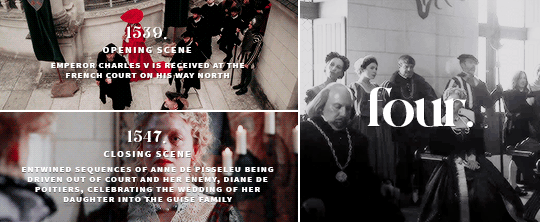
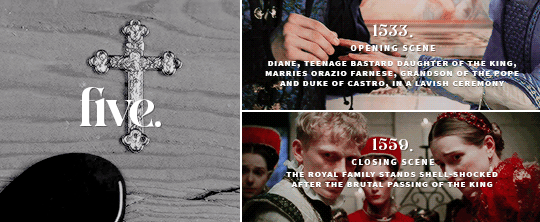
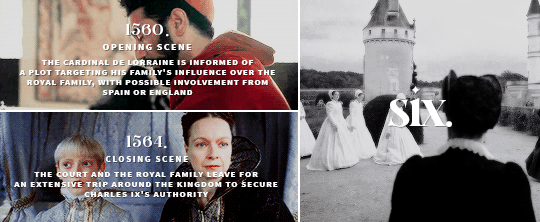

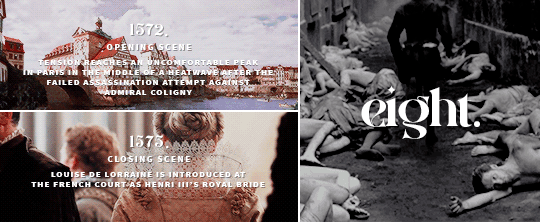



K I N G S I D E, a tale of seven kings
first season 1514-1520. Claude and François finally get married, a vacant seat for Mary Tudor, Louise of Savoy's stubborness to keep her son in check. A new King arises, the New Order, François' quest for glory in Italy. Another crown, another campaign.
second season 1522-1530. The inheritance dispute that leads Bourbon to treason. The pursuit of the italian dream, Claude dies, all is lost in Pavia. Süleyman and the unthinkable alliance, captivity in Spain. The Ottoman fleet. Royal depression. The inheritance dispute that led Bourbon to treason. The ladies' peace, Henry VIII flinching, a price for two princes, a New wife for the King.
third season 1531-1537. Louise dies, tensions between François and Marguerite. The wedding of Catherine and Henri. The rise of Pisseleu, the battle at Court between Charles and Henri and their people. War between Diane and Montmorency. Placards and the anti-heterics frenzy, another war in Italy. Wedding and death of Madeleine.
fourth season 1539-1547. Mending tensions between France and Spain. A very stubborn niece. All eyes on Henri and Catherine's sterile womb. Death of Charles. The duel in Jarnac. The King is dead, long live. Diane de Poitier's absolute triumph over Anne de Pisseleu. The Guises make their move.
fifth season 1553-1559. Diane of France's not so typical royal wedding. Catherine giving birth to the twins, Chenonceau goes to Diane, the cordial hate between the two. Rohan VS Nemours. Montmorency mess and a remarriage for Diane of France. The death of Henri, everything falls down.
sixth season 1560-1564. François II barely hanging on, Catherine's almost giving up, Elisabeth married off, the Guise family's counterpower, Montemorency's political exile, the Amboise conspiracy, preparations for the grand tour.
seventh season 1565-1572. The end of the grand tour, encounter between the royal family and Elisabeth, queen of Spain. The rise of Charles IX, a new queen, Marie Touchet and her bastard boys. Catherine's plans to get a match for Marguerite. Rising tensions between Charles and Henri after Jarnac and Montcontour. Marguerite's nuptials amidst tensions and Coligny's attempted murder.
eighth season 1572-1575. Coligny and the Protestant leaders rallying the troops. The Saint Barthelemew Massacre and the promise of Marguerite to never forgive her family. Catherine finds out Anjou's possible involvement. A new king for Poland. Marguerite's toubled married life. Death of Charles IX. Henri's escape from Poland and slow return to France.
nineth season 1581-1584. Catherine's illusions shatter. New King, no heir. Marguerite returns to Paris. Louise shows some spine against the King's favorites. Quarelling with Anjou, tensions with Elizabethan England, Anjou's election and subsequent death and Catherine's anger. The Guise family veering off the road.
tenth season 1585-1589. The mounting war of the three Henris. All eyes on King Henri who has no sons, Catherine's political exile, the slow burning of the last Valois children. Hunting down Marguerite from stronghold to stronghold, ending with her house arrest in Usson. Assassination of the Guise brothers, the death of Catherine, Henri III breaks down in Diane's arms. Marguerite in exile, Diane the only "true" daughter of Catherine's, as she sets out to (successfully) pacify the kingdom on her own.
#historyedit#perioddramaedit#mine#*#*kingside#16th century#so yeah this took me a whole month instead of a good week#we love crappy laptops
201 notes
·
View notes
Text

Portrait of Queen Jadwiga Anjou
Artist: Marcello Bacciarelli (Italian, 1731–1818)
Date: 1768-1771
Medium: Oil on tin plate
Collection: Royal Castle in Warsaw, Poland
Queen Jadwiga of Poland
Jadwiga (1373 or 1374 – 17 July 1399), also known as Hedwig (from German) and in Hungarian: Hedvig, was the first woman to be crowned as monarch of the Kingdom of Poland. She reigned from 16 October 1384 until her death. Born in Buda, she was the youngest daughter of Louis I of Hungary and Poland, and his wife, Elizabeth of Bosnia.
#portrait#painting#fine art#queen jadwiga of poland#polish queen#costume#head cover#crown#pearl necklace#polish history#hedwig#polish monarch#kingdom of poland#marcello bacciarelli#italian painter#oil painting#italian art#18th century painting#artwork#european art
23 notes
·
View notes
Text
Congratulations to today's champions!!
Be it known that these Competitors have triumphed on the Seventh and Last Day of Contest of Round One!
Faramir, Son of Denethor [David Wenham], The Lord of the Rings Trilogy (2001-2003)

Defeats Uther Pendragon [Gabriel Byrne], Excalibur (1981) with 92.7% of the Vote
Thorin Oakenshield [Richard Armitage], The Hobbit Trilogy (2012-2014)

Defeats King Edward IV Plantagenet [Max Irons], The White Queen (2013) with 82.9% of the Vote
Ètienne de Navarre [Rutger Hauer], Ladyhawke (1985)

Defeats Sultan Mehmed II [Cem Yiğit Üzümoğlu], Rise of Empires: Ottoman (2020-2022) with 69% of the Vote
Vlad III Dracula [Luke Evans], Dracula Untold (2014)

Defeats Nicodemus Ravens, The Shamer’s Daughter {Skammerens Datter} (2015) with 69.4% of the Vote
Turgut Alp [Cengiz Coşkun], Resurrection: Ertuğrul {Diriliş: Ertuğrul} (2014-2019)

Defeats King Edmund the Just [Mark Wells], The Chronicles of Narnia (2005-2010) with 76.2% of the Vote
Rodrigo Borgia [Jeremy Irons], The Borgias (2011-2013)

Defeats Lord Tywin Lannister [Charles Dance], Game of Thrones (2011-2019) with 50.4% of the Vote
Prince Charmont [Hugh Dancy], Ella Enchanted (2004)

Defeats “One-Eye” [Mads Mikkelsen], Valhalla Rising (2009) with 61% of the Vote
Adhemar, Count of Anjou [Rufus Sewell], A Knight's Tale (2001)

Defeats Robin Hood [Errol Flynn], The Adventures of Robin Hood (1938) with 65.3% of the Vote
King Arthur Pendragon [Bradley James], BBC’s Merlin (2008-2012)

Defeats Prince Henry [Dougray Scott], Ever After: A Cinderella Story (1998) with 60.8% of the Vote
Boromir, Son of Denethor [Sean Bean], The Lord of the Rings Trilogy (2001-2003)

Defeats Alessandro Farnese [Diarmuid Noyes], Borgia (2011-2014) with 90% of the Vote
Sir Lancelot [Santiago Cabrera], BBC’s Merlin (2008-2012)

Defeats Chu Hun [Peter Ho], Double World (2020) with 60.8% of the Vote
Westley [Cary Elwes], The Princess Bride (1987)

Defeats Sir Lancelot [Luc Simon], Lancelot du Lac (1974) with 78% of the Vote
49 notes
·
View notes
Text
I can only liken Alicent and Viserys' marriage to that of Elizabeth Woodville and Edward IV.
Elizabeth Woodville was, according to the times she lived, pretty much a commoner. She was the daughter of Richard Woodville, 1st Earl Rivers, and Jacquetta of Luxembourg. Her fathers title had to be swiftly thought up because Jacquetta, former aunt-by-marriage to the actual king, married so below her class. They earned even more titles and honors when Margaret of Anjou married Henry VI, whose brother was Jacquetta's brother in law.
So, in short, Elizabeth Woodville was the daughter of a noble and a servant. She, at the time of her marriage to Edward IV, was a widow and mother of two sons. She was not considered a good match for Edward, but according to history, it was a love match and they married in secret, and once out in the open, it caused an absolute shit show because Warwick, the Kingmaker, had planned on marrying Edward to the Princess Bona of France, but was completely blindsided by Edward's marriage to Elizabeth, a commoner. One of his own subjects.
Richard Neville, the Earl of Warwick, all but made Edward King and believed he would be enriched and given a multitude of honors for the troubles he went through to get Edward on the throne, but with Edwards marriage to Elizabeth came her sons and siblings and in-laws etc, and so her family were given riches and honors and lavish marriages rather than Warwick, which infuriated him (rightfully so, imo).
Warwick and Edward's dislike turned to pretty much open warfare, and several times would Warwick try and overthrow Edward, first with Edward's brother George, Duke of Clarence, by using the age old rumor that Edward was illegitimate and marrying George to Warwick's daughter Isabelle Neville, and Warwick executed Elizabeth's father Richard and brother John.
The second time, Warwick and George allied themselves with Margaret of Anjou and her and Henry VI's son Edward. Warwick's daughter Anne Neville was married to Edward, the Lancastrian heir, as part of the agreement, and Henry VI was put back on the throne, but it didn't last long, because Warwick and Edward's (son of Margaret) were killed in battle and the rebellion pretty much fell apart.
George, Duke of Clarence, would later be executed by being drowned, allegedly, in a vat of malmsey wine, for other reasons, and Edward's youngest brother, Richard, would usurp the throne from his nephew and become Richard III. He would be overthrown by Henry Tudor, who would marry Elizabeth of York, daughter of Edward IV and Elizabeth Woodville.
There was already a lot of unrest in England at this time, prior to Edward IV's marriage to Elizabeth, of course, but the king marrying a commoner and giving her oh, so common family honors and riches, snubbing the nobility, surely didn't help matters.
It's why I liken it to Alicent and Viserys. Alicent is pretty much a commoner. The daughter of a second son with barely a dowry - or one paid by her uncle, Lord Hightower - no lands, no armies, no armada, etc - so it makes sense that the rest of the nobility are mad, are kind of disgusted, but it annoys me that they're not more put out about it, which would be realistic, especially considering that the lords didn't bother putting their daughter's forth because they believed it to be a foregone conclusion that Viserys would stick with tradition and marry Laena Velaryon, a lady of Valyrian/Targaryen blood, but he didn't, and insulted a great many lords and young maidens, but of course that isn't shown in the show whatsoever 🙄
#anti alicent hightower#anti otto hightower#elizabeth woodville#Edward IV#wars of the roses#richard iii#george duke of clarence#george plantagenet#edward plantagenet#yorks#lancasters#asoiaf#hotd#house of the dragon#anti hotd#pro daemon targaryen#rhaenyra targaryen#daemon targaryen#me
24 notes
·
View notes
Text
"Through looking at Princess Rhaenyra and her historical counterpart Empress Matilda, I will argue that both these female characters are seen as having similar ambitions, weaknesses and characteristics as the men in their societies, however, because they are women these traits are represented as being undesirable.


Alicent’s ‘Green Council’ uses Rhaenyra’s gender as being the fundamental reason that she should not be Queen. The council notes how a trueborn son should always take precedence over a daughter. Further, Ser Otto states that Prince Daemon, as the husband of Rhaenyra will have the ultimate authority suggesting that, “we all know that one’s nature. Make no mistake, should Rhaenyra ever sit the Iron Throne, it will be Daemon who rules us, a king consort as cruel and unforgiving as Maegor ever was.” The way that the council is depicting Rhaenyra’s renders her incompetent due to her gender, suggesting that if she becomes Queen, she will be unable to make sound decisions and will be under the control of her husband. Although we see that is untrue throughout the rest of Princess and the Queen and her biography in A World in Ice and Fire, Alicent, Ser Otto and their council ultimately succeed in providing Aegon the support he needs.
[...]
Rhaenyra, though technically the rightful heir to the throne, is ostracized due to her gender and ultimately has few advantages in the war. It is noted in The Princess and the Queen that:
"Some older lords might yet recall the oaths they had swarn when she was made Princess of Dragonstone and named her father’s heir. There had been a time when she had been well loved by highborn and commons alike, when they had cheered her as the Realm’s Delight. Many a young lord and noble knight had sought her favor then…though how many would still fight for her now that she was a woman wed, her body aged and thickened by six childbirths, was a question that none could answer."
Through painting Princess Rhaenyra in this way, it can be seen as an attempt to appeal to the inherently patriarchal social structure they are situated in. Rhaenyra, despite a valiant effort, ultimately fails to access the power and agency she set forth to attain because it is suggested that this world of politics and level of power is ultimately a man’s domain. What is interesting however, is that Alicent succeeds in her effort to crown Aegon as king. As Valerie Estelle Frankie notes, Alicent “operates behind the scenes” and manipulates those around her into seeing Rhaenyra as the villain as she continuously degrades her as a “whore,” “bitch” and other derogatory terms. Alicent’s efforts can, in many ways be seen as more successful than Rhaenyra’s because rather than trying to usurp a male-sphere, she manipulates her way within it and through such, is able to find agency without disrupting social order.
Princess Rhaenyra has been referenced as directly paralleling the 12th century Empress Matilda. Matilda, much like Rhaenyra faced the problem of being a woman seek political agency in an inherently misogynistic society. [...] Like Rhaenyra who was in labour in Dragonstone when Aegon captured the throne, Matilda was in Anjou ‘pregnant and ill’ when her father suddenly died.
[...]
However, since gender renders women unequal, they are seen as significantly more problematic when trying to access power since they are essentially problematizing gender expectations. Matilda, performing as an ‘alternate monarch’ to many of her followers, was criticized by her contemporaries for subverting such gender structures. Frankel notes that, “As Matilda displayed to her subjects her ability to be as ruthless and forceful as her father… [Matilda’s contemporaries” could accept imperious behaviour from a king, but not from a woman, even one taking a king’s role.” Matilda, ultimately wanted to be a king, a position that was previously occupied by men, but as Frankel notes, England was “not ready for a reigning queen.” Therefore, her behaviours. though accepted when performed by a man, are rendered as being “insufferable”. Rhaenyra, similarily gets relegated to being insufferable and as it notes in the text,
“The girl that they once cheered as the Realm’s Delight had grown into a grasping and vindictive woman, men said, a queen as cruel as any king before her. One wit banned Rhaenyra “King Maegor with teats.”
Demonstrating how society has rendered her more monstrous as she has attempted to gain ‘male’ power.
What makes Rhaenyra such an interesting character is how her character is entirely a reflection of the cultural context she is situated in. Like Matilda, she has been given the duty to rule a Kingdom in a society that inherently discourages women to have any kind of personal or social agency. As a result, these women are forced to subvert gender roles and be relegated as cruel, evil and monstrous in their attempts to find agency."
Robin Daprato - Feminism and Misogyny in George R.R. Martin’s ‘The Princess and the Queen, or, The Blacks and the Greens’
35 notes
·
View notes
Text
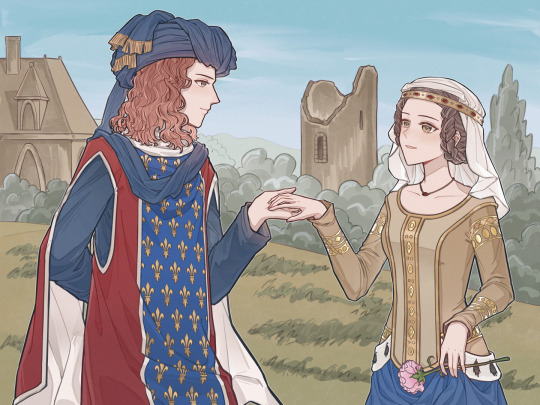
Thanks @hilda-dewitt for this great piece of work depicting Louis I of Anjou and Marie of Blois, great-grandparents of Margaret of Anjou. Louis I of Anjou was the founder of the Angevin cadet branch of the House of Valois, and Marie of Blois was the first of a series of powerful women in the House of Valois-Anjou.
I really found their story to be full of fun and drama. After King John II of France was taken prisoner in the Battle of Poitiers, Louis broke the Aragonese marriage contract arranged by his father to marry Marie, the daughter of one major claimant to the ducal throne of Brittany, neighboring his appanage of Anjou. His desire to meet his wife pushed him to end his hostage career in England prematurely on his own, and more or less led to the decision of John II to return to captivity, lol. While Marie's father fell in battle six months after John the Good's death in London, the couple remained close and intimate throughout their lives. Louis served as a leading military commander in his elder brother Charles V's reconquest of southwestern France during the second phase of the Hundred Years' War. He was also a loyal friend and protector of Bertrand du Guesclin, who fought for Marie's father before entering service for the Valois. However, due to his role in the 1378 tax revolts and his overambitious claim to the throne of Naples, Louis remained a controversial figure in France, and his past accomplishments were little appreciated. After Louis's death in the unsuccessful march to Naples, Marie continued their quest for the Neapolitan crown, and, after a tough fight against opposing claimants, secured for their seven-year-old son Louis II the County of Provence, which was in a personal union with the Kingdom of Naples. She acted as regent for Louis II during his minority, and arranged the marriage between him and Yolande of Aragon.
#Louis I of Anjou#Marie of Blois#hundred years war#medieval#fanart#historical fanart#french history#commission art#house of valois#margaret of anjou#Yolande of aragon
60 notes
·
View notes
Text
"The variety of accusations with Margaret [of Anjou] reveals the complexity of fifteenth-century anxieties about queenship and queenly authority. There was concern about dependence upon a foreign woman for a much needed heir to guarantee stability, fear of her potential to foster false heirs, fear of her potential to abuse her proximity to the king by drawing others close to the king at the expense of those who should have been his councilors, and fear of the potential for chaos and the subversion of right order in any daughter of Eve."
joanna laynesmith, "telling tales of adulterous queens in medieval england: from olympias of macedonia to elizabeth woodville."
#margaret of anjou#henry vi#wars of the roses#history#house of lancaster#house of york#women's history#royal history#english history#french history#medieval era#medieval history#middle ages#*quotes
40 notes
·
View notes
Note
Why was empress Mathilda not able to become the ruler?
Hi! There were lots of reasons, and historians have gone back and forth between them over the years. I am not an expert at all, but the way I see it, it was a combination of factors - be it social, structural, or plain bad luck - that resulted in Matilda's inability to claim the throne of England. To list a few I think were relevant:
Misogyny. After his son's death in 1120, Henry I's first instinct doesn't seem to have been to name his daughter his heir but instead to conceive another son with his second wife Adeliza of Louvain. William of Malmesbury wrote that the lords swore to accept Matilda as their sovereign only if Henry I died without a male heir; John of Worcester wrote that Henry designated Matilda as heir as "he had as yet no legitimate heir to the kingdom", implying that Matilda would be the one to provide that heir (ie: a son); and it seems that some of Matilda's supporters like Robert of Gloucester stressed the claims of infant Henry (the future Henry II) from the onset. Some historians have argued that Henry I wished to live long enough to transfer the kingdom and duchy to his eldest grandson, though this is of course mere speculation and Matilda would have been her father's immediate successor for the foreseeable future regardless. So even during Henry I's life, while Matilda was named heir and was expected to inherit & rule England, her exact situation appears to have been complex, and her gender was - directly or indirectly - at the heart of the complication.
Moreover, during the Anarchy, while Stephen technically did not justify or defend his claim to the throne explicitly because of his gender, there was clearly public debate over female succession at that time: for example, Matilda's illegitimate brother Robert of Gloucester was known to reference the Bible, where the Book of Numbers depicted God sanctioning female inheritance when there were no sons. This indicates that Matilda faced opposition from enemy quarters specifically for those reasons. Also, during Matilda's brief assumption of power as a female king, gendered ideals of masculinity/femininity and kingship/queenship entirely dictated public response to her and shaped her negative reputation.
Xenophobia. The Normans and Angevins were historic enemies, and many nobles were incredibly worried about Matilda’s second husband Geoffrey Plantagenet becoming king. I don't think it's a surprise that the Gesta Stephani repeatedly called Matilda "Countess of Anjou" or emphasized the presence of "Angevin knights" among her entourage. This had something to do with gendered expectations as well, but it was also likely meant to highlight Matilda's presumed foreignness, despite the fact that she was a princess of England by birth.
Complicated inheritance patterns. Succession in England, both before and after the Norman Conquest, was incredibly tricky. I'm not even going to get started on the Anglo-Saxons, but going by William the Conqueror's children: his eldest son rebelled against him, his second son inherited while keeping the eldest one imprisoned for life, and was in turn most likely murdered by the third son, who also kept the eldest son imprisoned for life. Hereditary claims were thus overridden in both cases. As Charles Beem points out in the Lioness Roared about Matilda's own father: "Henry I promoted a system of lineal inheritance based on a firm rule of primogeniture [for his children]. However, his own legitimacy as king was not based on this principle, a concept that infiltrated Anglo-Norman inheritance practices during his reign. Instead, he based his self-representation as a legitimate king on a medieval hodge-podge of justifications: porphyrogeniture, or having been “born to the purple” after his father had become king of England, sacralization from his anointing and consecration, and the acclamation of the people: Finally, Henry I secured papal recognition for his title, and convinced Pope Calixtus II to reject the claims of William Clito, the son of Henry’s eldest brother Robert Curthose, in effect dealing a severe blow to the legitimacy of primogeniture." So even in an ideal scenario, the idea of a designated heir and eldest child succeeding without hindrance would have been unusual. Unfortunately, this was not an ideal scenario by any circumstances.
Also, England seems to have functioned with an interregnum at that time, meaning that Matilda would not have been immediately considered ruler upon her father's death. To quote Beem: "To become king of England in the year 1135 required positive, immediate action; although the theory of the king’s two bodies had already begun to develop, the idea that an immediate succession occurred upon the death of a king had not. Instead, an interregnum occurred, which ended only when the crown was placed on the next king’s head. This had been the case with William Rufus’s accession in 1087 and that of Henry I in 1100, both of whom overrode the hereditary claims of William the Conqueror’s eldest son Robert Curthose. Although Matilda had received oaths to support her candidacy, the oaths in themselves did not make her king. Like her uncle and her father before her, Matilda needed to be physically present in London, to receive formal homage from her tenants-in-chief, to accept the acclamation of the people, and to be anointed and crowned in Westminster by the archbishop of Canterbury". I think the first heir to be regarded as king despite not being physically present in the country was Edward I in 1272 - a while away. Which brings me to...
Bad Luck. At the time of her father's death, Matilda wasn't in England or Normandy. She seems to have left her father's court after a disagreement where he refused to be reconciled with William Talvas without punishing him despite Matilda's wishes on the contrary. As Robert of Torigny notes, in the end of 1135, "the empress Matilda, who he [Henry I] had long before appointed heir to his realm, was staying in Anjou with her husband count Geoffrey and her sons"; William of Malmesbury likewise stated that she was staying in France “for certain reasons.” The fact that Matilda wasn't physcally present made it easy for Stephen and the nobles to sideline her and overrule Henry I's appointment.
Matilda was also pregnant at the time, and it's possible that this prevented her for making the crossing, either due to physical reasons (we know she nearly died during her second childbirth) or due to ideological ones (she may have "considered such a state to be a liability in constructing herself as a viable contender for an office essentially gendered male", as Beem speculates).
An insufficient power base: Yet another one of her misfortunes was the fact that Henry I seems to have withheld his daughter's dowry till the end of his life. For example, Torigny writes that "the king was unwilling to do the fealty required by his daughter and her husband for all castles in Normandy and in England". Nor does Henry seem to have associated her with direct kingly governance during his life that could have made the transition to rulership more natural for her and for English & Norman magnates. This meant that Matilda and Geoffrey didn't seem to have had a solid power base to rely on at the time of her father's death with which she could directly launch her claim. It's no surprise that their first move was to try and secure her dowry castles (Exmes, Domfront, Argentan, Ambrières, Gorron, Colmont, etc), and that Matilda installed herself in one of them.
And, of course, Matilda's ultimate bad luck was the existence of a rival claimant (Stephen) with sufficient resources and backing who chose to press his own - theoretically inferior - claim. Ultimately, after the majority of nobles sided with or acquiesced to Stephen, Matilda's doors were shut - without tangible support, she was stuck. It's not surprising that it was only after Stephen began to alienate his followers (particularly Robert of Gloucester, who had initially supported him) a few years later that Matilda got an opportunity to press home her advantage.
Hope this helps!
#obligatory disclaimer that I'm not an expert at this and may have fumbled in a few places (I don't think so but just in case)#empress matilda#12th century#english history#the anarchy#my post#queue#I'll edit this some more in a bit (maybe)#ask
22 notes
·
View notes
Text
Ryu Number: Jack Jackson
In 1120, the son—and anticipated heir—of King Henry I of England died in a maritime accident. In a time and place where a succession crisis popped off every time a monarch bit it even with preparation beforehand, this was Kind Of Bad.
The only legitimate child Henry I had left was Matilda (also called Maud), who'd been married to the Holy Roman Empire for a while, but was now married to the Count of Anjou, who was Not Popular, especially among the sort of people you wanted to be popular among if you wanted them to be alright with you ruling the kingdom. Henry I tried to go to bat for Matilda, but time ran out, and in 1135, he died. And that's just about when the Anarchy began.
...No, really, that's what the civil war was called: "The Anarchy." I would rather not have a civil war, but you've got to admit that that's a pretty hardcore name for one. Also actually it actually took a few years for Matilda to set up and get to civil-warring, but "and after a few years the Anarchy began" doesn't sound nearly as cool, right?
Matilda's main opponent in this game of thrones was Henry I's nephew, Stephen of Blois, who, having the good fortune to actually be in the area, wasted no time taking the reins. An awful lot of stuff happened after, but eventually everyone got real sick of fighting and in 1153 the big names hammered out the Treaty of Wallingford, that agreed that Stephen would be king, actually, but once he shuffled off Matilda's son—also named Henry, because history isn't hard enough to keep track of already—would take the throne.
...This isn't really about any of these guys, though.
The Pillars of the Earth is a 1989 historical fiction novel by Welsh author Ken Follett. Using the Anarchy and related events as a backdrop, it tells the story of a lot of folks from the priory and village of Kingsbridge, England having a Real Subpar Time. Secrets and Politics happen, a lot of it churchish, and it trickles down to the little people in the worst of ways.
Also there's a bunch about building cathedrals; some folks in the book are Really Deep Into That, especially Jack Jackson, one of the more important characters from the book who gets dealt a rotten hand and makes do nonetheless.
It's not the sort of media you'd expect to get a video game adaptation out of, but it got one anyway.

And I'm definitely not complaining, 'cause that means Jack Jackson has a Ryu Number of at most 3.

...Guess who finally finished studying the newest Age of Empires II: Definitive Edition DLC? Victors and Vanquished features a numbers of historical scenarios, including one where you play as Henry's nephew, Stephen, Stephen's brother, Henry, and Stephen's wife, Matilda, against the armies of Henry's daughter, Matilda, and Matilda's son, Henry.
This is giving me flashbacks back to elementary school when every third girl was named either Ashley or Jessica. I cut the knot by simply remembering no one's name, which worked badly.
Anyway, as a bonus, have this list of characters who—taking into account only the games I have gone through myself—appear only in Age of Empires II: Definitive Edition.

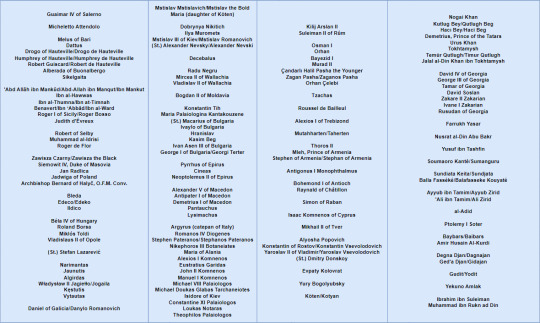
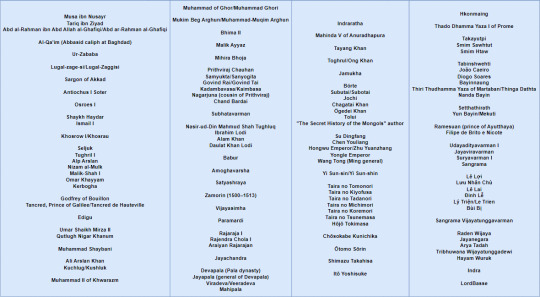
#ryu number#ryu#teppen#oda nobunaga#age of empires ii: definitive edition#stephen king of england#ken follett's pillars of the earth#jack jackson
52 notes
·
View notes
Text
I wonder whether GRRM might use the marriage of Margaret of Anjou to Henry VI of England as partial inspiration for the betrothal and marriage of Myriah Martell to the future King Daeron II.
I certainly believe, after all, that GRRM has used, and will use, Henry VI as an inspiration for King Baelor (in addition, of course, to the author’s explicitly stated point of reference for the septon-king, Louis IX of France). Both kings had succeeded conquering warriors who had themselves looked to make good on ancestral dynastic claims to foreign kingdoms - and, to some limited and impermanent extent, succeeded in doing so. In turn, however, both Henry VI and Baelor, each later famed for their piety, expressed an interest not into stepping into their predecessors’ shoes but in bringing about peaceable ends to their respective wars. Not only did both peace endeavors include the surrender of important aristocratic hostages - the Duke of Orleans by King Henry, the children of Dorne’s blue blooded families by King Baelor - but these efforts also included royal marriages with high-ranking families in these recently enemy territories - Baelor arranging the marriage of his young cousin Daeron to the Dornish princess Myriah Martell, Henry VI agreeing to a marriage between himself and Margaret of Anjou.
Unfortunately for the idealistic Henry VI, the marriage between himself and Margaret of Anjou neither ended war with France nor provided additional gains for England. Margaret’s cash dowry was relatively small - 20,000 francs - and though her father promised to include Margaret’s maternal claims to Mallorca and Menorca, these territories had been claimed by the crown of Aragon for centuries, and were a practical impossibility for England to occupy. Worse, shortly after Margaret’s coronation, King Henry VI agreed to surrender the county of Maine and abandon English claims to the territory of Anjou, in the hopes of obtaining a truce with France. The king’s aspiration for such a peaceful settlement were, however, in vain: within five years of Margaret’s marriage to Henry, the French king (with Margaret’s father René at his side) had retaken Normandy, and three years later England lost Gascony - its last major holding, besides the tiny toehold of Calais, from the conquests of the Hundred Years��� War and the inheritance of his Plantagenet predecessors.
In turn, I wonder whether GRRM will look to model Myriah Martell’s betrothal to Daeron. Just as Margaret was a French princess and niece (by marriage, at least) of the King of France - that is, a high-ranking female relative of the ruling family which had so recently opposed the last king’s conquest - so Myriah Martell was a princess of Dorne, daughter of the (unnamed) Prince of Dorne who had bent the knee to Daeron I. Margaret was not her father’s heir, as Myriah Martell certainly was (as the eldest child of the Prince of Dorne), but both princesses saw territorial returns to their paternal families in connection with their marriages to the royal successors of the fathers’ conquerors. Just as Henry VI agreed to surrender Maine (and his claim to Anjou) to Margaret’s father René in the hopes of sealing long-term peace between his realm and that of King Charles VII of France, so Baelor the Blessed agreed to a marriage between Prince Daeron and Princess Myriah as part of an agreement of peace between Dorne and the Iron Throne - with, presumably, a promise that the Iron Throne would not try to assert control over the late King Daeron’s conquered land. Consequently, I wonder whether the same deep unpopularity of the decision to surrender Maine - indeed, the Duke of Suffolk, blamed as the chief architect of this agreement, was impeached by the House of Commons on these grounds, among others, and shortly thereafter murdered - would have extended to this decision by Baelor, and by extension to Myriah herself - a princess whose betrothal, enemies of this decision may have asserted, came not with a rich dowry for a would-be future king but instead a return of lands conquered by the Iron Throne.
38 notes
·
View notes
Note
https://www.tumblr.com/nrilliree/747663914665459712?source=share
It's really crazy how much TG lives in their own fanfiction.
This person also refuses and seems to understand that it is misogynistic that Rhaenyra ended up with a nickname equivalent to Maegor simply for arguing about taxes. Something that was advised to her by a man on her council, not even her idea. And what else could she do anyway ? There was no more money because the Greens took everything ! But obviously, it's all Rhaenyra's fault. Also, I find it hard to understand how the TG are good sovereigns when we see how they manage money ?
Also, the simple fact that she doesn't seem to accept and understand that Rhaenyra had more than half the kingdom on her side ? That the Greens weren't tied or had a majority ? She almost acts like everyone obviously wants to support them.
She advocates neutrality while she is openly TG, it annoys me.
Anyway, coming from a person who thinks that I can't read and don't know anything about the GRRM universe simply because I told a simple truth ; namely that women could not become Kingsguard. A truth according to her that is false because since Visenya created the Kingsguard, apparently that means that women can be too ? Sorry, but how can we seriously support such a stupid thing ? It's not because Visenya created the Kingsguard that women can become one! In the era of ASOIAF / GOT a woman can't even be a knight ! So Kingsguard in the time of Rhaenyra ?! Make me laugh !
She's also exactly the kind of person who will try to explain to you that Rhaenyra can't be the legitimate heir because apparently there is no legitimate heir under the pretext that the law is vague. Stupid, the only real law that matters is the word of the king. It kills me that they are trying so hard to deny it ?!
I'm not going to talk about our least favorite troll, so I won't refer to her statement, but rather the general attitude among TGs.
Alicent's mistakes and crimes are explained by the fact that it was not her fault, but the evil men around her who coerced and manipulated her. She is a victim of evil men. Rhaenyra's mistakes and crimes are Rhaenyra's mistakes and crimes. The end.
This is what some people think.
This can be extended further to other TG characters: Did Helaena go crazy and commit suicide after her children died? Poor thing, it was completely explainable, the death of murdered children is a huge tragedy that will devastate everyone! Rhaenyra went crazy and paranoid after the death of her children? This is no explanation! You can't explain this to her, she's a terrible tyrant!
Rhaenyra's reign was not good, but there was much more to it than the fact that Rhaenyra "is evil, spoiled, narcissistic and generally yuck." People accuse her of not being a feminist because she didn't decree that from now on all daughters would inherit on an equal footing with sons… Do any of these people even know how emancipation developed in the real world? It didn't work that way. Rhaenyra was to be the first woman in power. It was the first step, and true emancipation often takes generations. In Poland we had Jadwiga of Anjou and guess what? She took the throne as a king, not a queen, so she could rule, and that didn't miraculously result in women being treated equally to men from then on. Rhaenyra listened to her advisors and therefore did not decree that daughters would inherit before sons or cousins, because she knew she could not make too many changes in one moment. She listened to the advisors, but it was still her fault. It's just as much her fault for stealing the Driftmark from Baela and Rhaena… even if Corlys preferred to legitimize his bastard and make him heir rather than give the inheritance to Laena's daughters! Rhaenyra is fully to blame for the riots and dragon slaying, even if the Shepherd was simply looking for a suitable excuse to overthrow the rich and lords. It wasn't even about Rhaenyra, and if Aegon had been on the throne then, there would have been riots anyway. The Shepherd would simply find another reason! For example, the fact that people were starving and Aegon built golden statues of war criminals…
She realizes that Rhaenyra was not a good queen, but that was due to the situation. War, lack of money, riots incited by the Shepherd, and on top of her own emotional problems that resulted from almost her entire family being killed. If someone doesn't see it, he or she is simply a TG pro, not a "neutral" person who, strangely enough, justifies only one side of the conflict.
#house of the dragon#team black#anti team green#hotd#pro team black#rhaenyra targaryen#anti alicent hightower#anti team green stans
24 notes
·
View notes
Text
medieval women week day 2: Favorite non-Queen or Queen-adjacent royal woman: Jacquetta of Luxembourg Duchess of Bedford and Mother to Queen Elizabeth Woodville




Jacquetta of Luxembourg was the eldest child of the French Count of St Pol; her family descended from Charlemagne and were cousins to the Holy Roman Emperor. She grew up with war between France and England raging around her.
John, Duke of Bedford was the youngest son of King Henry IV. Having lost his wife to plague in 1432, he arranged to marry the seventeen-year-old Jacquetta, who was his social equal by her birth. Although married for two years they were childless when John died in September 1435. The King instructed Jacquetta to come to England and ordered Sir Richard Woodville, to arrange it.
However, Jacquetta and Richard fell in love, but Richard was a poor knight, far below Jacquetta in social status. Nonetheless, they married secretly thus thwarting any plans King Henry may have had to marry her off to a wealthy English lord. Theirs was a morganatic marriage, where one of the partners, most often the wife, was socially inferior. Henry was enraged and fined the couple £1000. He did however allow their heirs to inherit, which was unusual for morganatic marriages in England.
Being the widow of Henry V’s brother and aunt to the King, royal protocol gave Jacquetta the highest rank at court of any female except Henry’s wife, Margaret of Anjou, to whom Jacquetta was related by marriage. She even ‘outranked’ the King’s mother and was referred to as the ‘Duchess of Bedford,’ retaining the title from her first marriage. Richard and Jacquetta lived in their manor house at Grafton Regis near Northampton producing fourteen children, the eldest, Elizabeth being born in 1437.
In 1448 Richard was created Lord Rivers: his advancement ensured his family supported Henry VI in the dynastic feuding of the Wars of the Roses. The situation changed with the Yorkist victory at the Battle of Towton in 1461 and the seizure of the throne by Edward IV. By the spring of 1464, Jacquetta’s daughter Elizabeth was a widow, her Lancastrian husband having been killed in 1461. Within a few months, Elizabeth was married to the young King Edward IV.
Jacquetta died in 1472 aged 56 and was buried at Grafton, though no record of her tomb survives. Recently, one legacy has come to light. Research by gene specialists indicates that Jacquetta was a carrier of the rare Kell-Antigen-Mcleod syndrome causing impaired fertility and psychotic behavioural changes in the male descendants of the family.
Written by Michael Long. I have over 30 years experience teaching History in schools and examiner History to A level. My specialist area is England in the 15th and 16th centuries. I am now a freelance writer and historian.
#medievalwomenweek#jacquetta of luxembourg#day 2#wars of the roses#the white queen#The painting at the bottom right isn't Jacquetta but it's how I love to picture her and Richard Woodville together. My favorite couple from#this era
14 notes
·
View notes
Photo




“Now, Bishop Gervais so cherished Hugh, whom he had held on the baptismal font, that he sought for him the hand of the noblest lady Bertha, formerly wife of Alan, Count of Brittany.” This Alain had died in the year 1040. He had had a son from Bertha, the brave Conan, who was poisoned under the walls of Château-Gontier. Bertha was the daughter of Odo II, Count of Blois. "This greatly displeased Count Geoffrey," adds the annalist, "as the event proved. Hugh went with his men-at-arms to Bertha; Geoffrey ran to the Château-du-Loir and set it on fire. "In a charter that we have already mentioned (1), we find some details about the siege of the Château-du-Loir. Geoffrey did not seize it, but he ravaged the streets of the square, the village that surrounded it, and even a church founded in honor of Saint Guingalois, where Gervais had recently established canons. The soldiers of the Count of Anjou dispersed them. These actions,” we read in our manuscript, "now rendered the count to the bishop and the bishop to the count odious to each other. Geoffrey, therefore, seeing that, by the advice of Gervais, who wanted to harm and lose him, Count Hugh had taken a very powerful woman, and carrying Judas in his heart, called the bishop near him, in order to treacherously surprise him. Having seized him, he had him thrown into prison and held him in irons for seven years, hoping to thus make himself master of the Château-du-Loir. But it was of no use to him, because the castle was well defended by the garrison. While these things were going on, Count Hugh died, the bishop Gervais being still a prisoner. This death greatly afflicted the bishop and greatly delighted the Count of Anjou.” Count Geoffrey ruled the province for ten years. Indeed, the inhabitants of Le Mans having driven out the grieving widow of Hugh with her children through one of the gates of the city, had Count Geoffrey enter their walls full of joy.
- Jean-Barthélemy Hauréau, Histoire Littéraire du Maine: Tome 5
20 notes
·
View notes
Note
How is the relationship between Margaret of Anjou and Jacqueta of Luxembourg? (Jacquetta was one of the three people who convinced her not to enter London, which made me fantasize about their relationship.)
We simply don't know a lot about their relationship. Jacquetta does seem to be prominent at court during Margaret's time as queen consort but we don't know if this indicates - or led to - any personal closeness between the women. We know the Woodvilles had a close affiliation with the House of Lancaster and Jacquetta was the widow of Henry VI's uncle, John, Duke of Bedford and the dowager Duchess of Bedford so that may well have been the reason for her prominence. Jacquetta could also claim a familial connection with Margaret herself: her sister, Isabel, had married Margaret's uncle, Charles of Anjou, Count of Maine. The idea that Jacquetta and Margaret were especially close seems to have been popularised by Philippa Gregory in her novel, The Lady of the Rivers, and her biography of Jacquetta in The Women of the Cousins' War but historians are more cautious.
Jacquetta and her husband were part of Margaret's escort to England in 1445. According to B. M. Cron, Jacquetta attended Margaret's coronation banquet and was seated on Margaret's right - this is far more likely to be due to her being the first lady in the land after Margaret than an indication of their closeness; Humphrey, Duke of Gloucester was seated on Margaret's left and the idea of Gloucester being a close friend of Margaret is not credible. Cron also claims that Richard Woodville was Margaret's champion in the jousting festivities that followed. Lynda J. Pidgeon claims it is "significant" that Richard Woodville was not created a baron until after Henry VI's marriage to Margaret, but credits it more to Henry's desire to "create a royal family around him" than to any relationship between Margaret and her escort.
Jacquetta's servants were regularly given gifts by Margaret in the New Years celebrations. In 1446, her servants received 53s. 4d. and in 1447, 1449 and 1452, Jacquetta's servants received 66s. 8d. This is on a par with other gifts to ducal servants - in 1446, this was the same amount given to the servants of the Duke of York and Duchesses of Buckingham and Exeter, while in 1447, the same amount was given to the servants of the Duke of Gloucester, the Archbishop of Canterbury and the Duchess of Buckingham. Jacquetta herself was only given gifts by Margaret in 1447 and 1452 according to Pidgeon but I'm not sure what the source is for that and neither Helen Maurer nor A. R. Myers mention it when discussing Margaret's accounts. Not all of Margaret's accounts survive so we don't have the full picture.
Jacquetta attended Margaret's churching after the birth of Edward of Lancaster in 1453. Jacquetta and her husband were part of Margaret's court during her extended stay in the midlands beginning in 1456, though, according to Pidgeon, they are only rarely mentioned as being present. This is may have been due to the frequency of Jacquetta's pregnancies keeping her away from court.
And yes, Jacquetta was one of three women (the others being Lady Scales and Anne, the dowager Duchess of Buckingham) who accompanied a delegation of London aldermen who convinced Margaret to send her army away. As Helen Maurer says:
Both Jacquetta, the dowager duchess of Bedford, and Ismania, Lady Scales, had been among the women who had escorted Margaret from France, and Lady Scales had remained in her household as a personal attendant. All three ladies had been recipients of New Year's gifts at various times, and Anne, duchess of Buckingham had stood godmother to Prince Edward. Though the personal relationships that existed between Margaret and these women are difficult to assess, it is apparent that the mayor and aldermen believed that they would be received with trust and favor.
Jacquetta's prominence at the Lancastrian court may explain the tradition that her daughter, Elizabeth Woodville, was a lady-in-waiting to Margaret. There is, however, no evidence of that Elizabeth served Margaret and historians have generally poured doubt on the idea. One exception is Susan Higginbotham who suggested that it is still possible that Elizabeth was one of Margaret's damsels, saying if that Elizabeth did serve Margaret , it's "more likely that she did so in the late 1450s, a period for which Margaret's household records do not survive".
There is no evidence to tell us what Margaret thought of the marriage of Elizabeth Woodville and Edward IV or the Woodvilles' defection to the House of York. There is no evidence Jacquetta and Elizabeth feared Margaret especially during the Readeption - it would be very, very surprising if they feared her more than Richard Neville, Earl of Warwick (after all, it was in Warwick's attempt to depose Edward IV in favour of George, Duke of Clarence that had seen Jacquetta's husband and son executed, presumably without trial).
Nor do we know if, in the aftermath of the Lancastrian defeat at the Battle of Tewkesbury and Margaret's capture by Yorkist forces, whether Jacquetta met with or attempted to advocate for Margaret before her own death in 1472. We do not know if anyone advocated for Margaret's imprisonment to made more bearable, who decided her jailer would be Alice Chaucer, dowager Duchess of Suffolk and an old friend. If anyone did, I suspect it would be Jacquetta or Elizabeth Woodville (possibly in memory of her mother's friendship). It is tempting to speculate that Margaret's entry into the London Skinners’ Fraternity of the Assumption of the Virgin Mary in c. 1475 came about due to Elizabeth's influence (Elizabeth had entered the fraternity in c. 1472) but there's simply no evidence of it. It makes for a nice story, though.
In contrast to Maurer, Pidgeon is fairly doubtful of the idea that Jacquetta and Margaret were friendly, citing first the lack of mention of their attendance on Margaret and the lack of New Year's years gifts given to Jacquetta, saying:
Margaret’s apparent lack of friendship for Jacquetta might also be explained by Jacquetta’s Burgundian connections. Jacquetta’s father had been responsible for the capture of Margaret’s father at the Battle of Bulgnéville in 1431, following which René had been held prisoner by the Duke of Burgundy for some years until his ransom was paid. Margaret was also concerned to promote French interests to Henry and any reminder of a previous Burgundian policy might have been frowned upon. It was widely believed that it was through Margaret’s prompting that Henry had agreed to surrender Maine to René of Anjou in 1445.
However, Pidgeon bases some of this on the claim that Margaret "probably detested" the English, which we don't know and seems to be drawn from Yorkist and Tudor stereotypes of Margaret. As for the claim that Margaret pushed for Henry VI to surrender Maine to her father, it is true that she was blamed for it but what role, if any, she actually played is unknown. It is more likely that the surrender of both Maine and Anjou was an unofficial promise made by the English delegation in the negotiations that resulted in the Treaty of Tours (1444). Given Margaret was a 14-year-old girl at the time, it is incredibly unlikely she was responsible for that promise. She was urged to intercede with Henry to ensure the fulfilment of that promise but we simply don't know if she did or even what she thought about it. As I say here, she was still in her teens when the handover occurred and we must be wary of the misogyny embedded in the narrative that a teenage girl was responsible for the actions of an adult man - who, after all, was surrounded by experienced and mature advisors.
In short, the answer is that we don't know what the relationship between Margaret and Jacquetta was like. We see Jacquetta given favour in keeping with her status as a duchess and in keeping with her family connections to both Margaret and Henry. If any special relationship grew up between Jacquetta and Margaret, if they became close friends, there is little evidence to show it.
The Woodvilles were loyal to the Lancastrians throughout the resumption of the Hundred Years War until the Lancastrian defeat at the Battle of Towton. How much of that can be credited to the Woodvilles' traditional loyalties or Jacquetta's personal ties to Henry VI (who, after all, was her nephew by marriage) versus a (hypothetical) close relationship between Margaret and Jacquetta is unknown.
Philippa Gregory made much of this limited evidence, while Maurer more cautiously suggests that Margaret looked on Jacquetta as someone she could trust. Pidgeon, on the other hand, argues that there was no friendship between the women. I have my suspicions about why Pidgeon argues that (I haven't read her whole book so I can't say for sure).
Personally, I've tended to imagine a connection that dimmed over time due to diverging lives - Jacquetta's frequent pregnancies kept her away from court, Margaret's life became absorbed by the political struggles of the Lancastrian court. The simple fact is that we don't know - there isn't anywhere enough evidence to judge - and you're free to imagine what you like.
Sources
B. M. Cron, Margaret of Anjou and the Men Around Her (History and Heritage Publishing 2021)
Philippa Gregory, David Baldwin and Michael Jones, The Women of the Cousins' War: The Duchess, the Queen, and the King's Mother (Atria Books 2011)
Susan Higginbotham, The Woodvilles (The History Press 2013)
Helen Maurer, Margaret of Anjou: Queenship and Power in Late Medieval England (Boydell Press 2003)
A. R. Myers, "The Jewels of Queen Margaret of Anjou", Bulletin of the John Rylands Library, vol. 42, no. 1 (1959)
Lynda J. Pigdeon, Brought Up Of Nought: A History of the Woodville Family (Fonthill 2019)
13 notes
·
View notes